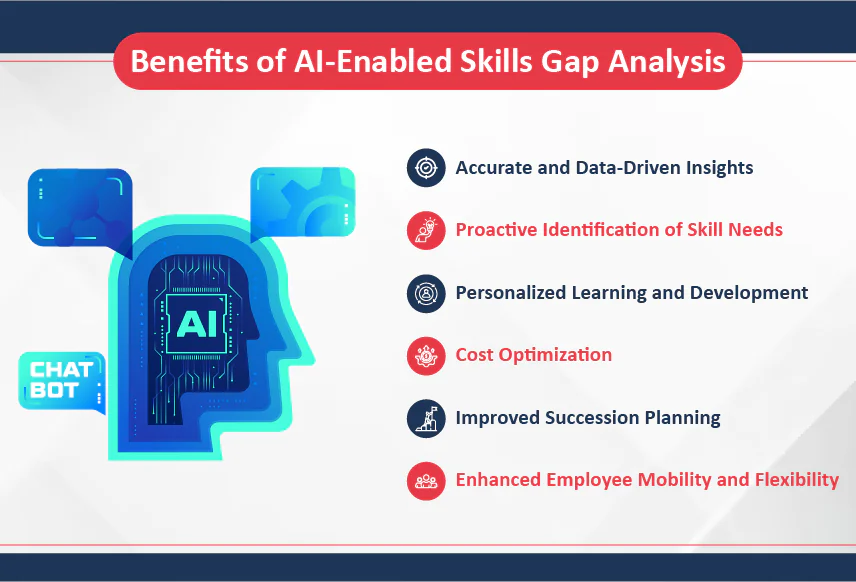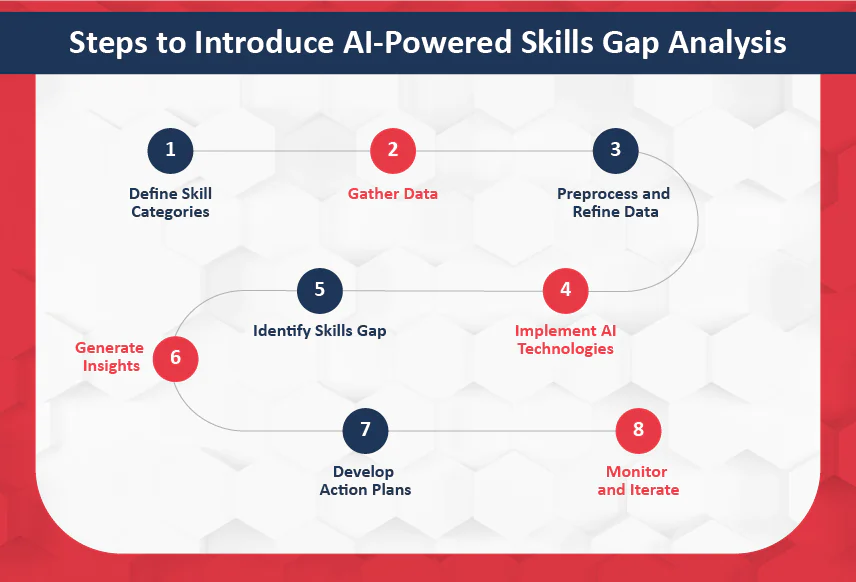
Identifying and addressing the skills gap within your workforce can be challenging. That’s where skills gap analysis implementation using AI can help. By harnessing the capabilities of AI, you can transform large data sets into actionable insights to identify and address skills gap with utmost precision.
No longer do you have to rely on human-driven time-consuming skills gap analysis. Today, you can automate this process with AI to upskill, reskill, and cross-skill your employees for future-proofing your organization.
In this blog post, we will explore how AI can automate the implementation of skills gap analysis and how you can leverage this technology to the best of your ability. But first, let’s take a look at the bigger picture of skills gap analysis.
The Current Scenario of Skills Gap Analysis
The employment landscape is witnessing a significant shift in terms of corporate skills. There is a staggering contradiction between the proficiencies employees bring to the table and the skills demanded by an ever-changing business environment.
According To A LinkedIn 2023 Workplace Learning Report, The Required Skill Sets For Jobs Have Undergone A 25% Transformation Since 2015, And It Is Projected To Reach 50% By 2027.
However, many employers still rely on traditional methods to perform skills gap analysis. They manually conduct surveys, interviews, and performance evaluations to identify competencies gap within the organization.
There are some notable challenges and limitations associated with this approach. It is time-consuming, especially for organizations with a significant workforce. On the other hand, you need to invest substantial resources in collecting, collating, and analyzing data from multiple sources.
Manual skills gap analysis is prone to subjectivity and biases. Evaluating skills and competencies relies on human judgment, which introduces assessment inconsistencies and variations. This subjectivity affects the accuracy and reliability of the outcome.
6 Major Benefits of Automating Skills Gap Analysis Implementation Using AI
According to Salesforce, 56% of hiring managers say that AI and related workplace automation will cause a major shift in the kinds of skills employees need to possess.
This means skills gap analysis implementation using AI can be a transformative approach to address the challenges posed by the skills gap in organizations. It can highlight areas where specific skills could be improved or in high demand.
Skills gap analysis using AI can help you automate talent development by devising successful strategies for skills gap analysis automation. Here are some crucial benefits of skills gap analysis implementation using AI to give you a better idea.

1. Accurate and Data-Driven Insights
AI technology enables you to gather and analyze vast amounts of data quickly and accurately. By leveraging AI algorithms, you can gain valuable insights into the current skills landscape, identify specific skills gap, and make informed decisions based on data-driven assessments.
2. Proactive Identification of Skill Needs
Using AI to implement skills gap analysis can identify emerging skills gap and forecast future requirements. It helps you stay ahead of industry trends and plan for skill development initiatives in advance. This ensures that your organization has the right talent with the required skills when needed.
3. Personalized Learning and Development
AI can facilitate personalized learning experiences by assessing employee skills, preferences, and career aspirations. AI models can automatically recommend training programs, resources, and development opportunities tailored to each employee’s needs.
4. Cost Optimization
Skills gap analysis implementation using AI helps you focus on targeted skill development initiatives. It assists you in avoiding unnecessary training expenses and allocating resources efficiently where they will have the most impact.
5. Improved Succession Planning
AI-powered skills gap analysis helps identify critical skills gap within key roles in an organization. This information can aid in developing robust succession plans, ensure a smooth transition of talent, and minimize disruptions during leadership changes or employee turnover.
6. Enhanced Employee Mobility and Flexibility
Skills gap analysis implementation using AI can identify transferable skills within the organization, enabling employees to explore new roles and career paths. This promotes employee mobility and flexibility, fostering a dynamic and adaptable workforce.
8 Easy Steps to Automate Skills Gap Analysis Implementation Using AI
An important question that must have crossed your mind while reading all the above is how to implement skills gap analysis using AI. Now to worry, we have prepared a curated list of steps that you can follow to make the most out of this technology.

1. Define Skill Categories
The first step is identifying the skill categories relevant to your organization. These could include technical skills, soft skills, and industry-specific skills. You must clearly define the skills within each category that are critical for your workforce.
2. Gather Data
Collect data from various sources, such as employee performance records, job descriptions, industry reports, and skill frameworks. Ensure that the data is comprehensive and representative of the skills possessed by your workforce and the skills required for each job role.
3. Preprocess and Refine Data
The next step to enable skills gap analysis implementation using AI is refining and preprocessing the collected data. This will remove inconsistencies, duplicates, or errors. You must standardize the data format to ensure compatibility and accuracy.
4. Implement AI Technologies
Employ machine learning algorithms, natural language processing, AI models, and transformers to analyze the refined data. You must train the AI model using historical data and the desired outcomes of the skills gap analysis.
5. Identify Skills Gap
Utilize AI models and transformers to automate your skills gap analysis process. It will help you quickly compare employees’ skills with those required for the job roles. It will also help you effectively identify emerging skill needs based on industry trends and future projections.
Learn how Harbinger helped a leadership skilling solutions provider automate skills gap analysis by deploying AI models and Transformers.
6. Generate Insights
Interpret the analysis results and generate actionable insights. These insights could include specific skills gap, high-demand skills, potential risks, and opportunities for skills development and talent acquisition.
7. Develop Action Plans
Based on the insights, develop tailored action plans to address the identified skills gap. Train the AI model to automatically provide upskilling and reskilling recommendations in the form of training programs, certifications, and mentoring.
8. Monitor and Iterate
Continuously monitor the progress of the implemented action plans and evaluate their effectiveness. Utilize AI algorithms to track skills development and assess the impact of the interventions. Refine the analysis process and action plans based on ongoing feedback and results.
Want to maximize business growth by automating skills gap analysis?
A Way Toward AI-Driven Excellence
Automating skills gap analysis implementation using AI presents an exciting future for organizations seeking to optimize talent management. As AI advances, we can expect even more sophisticated algorithms and predictive models that provide deeper insights and accurate projections to address the skills gap.
If you want to harness the power of AI to automate skills gap analysis or seek dedicated assistance to accelerate your talent development initiatives using modern technologies, write to us at contact@harbingergroup.com. Our EdTech experts would be more than happy to help you meet your business goals.






